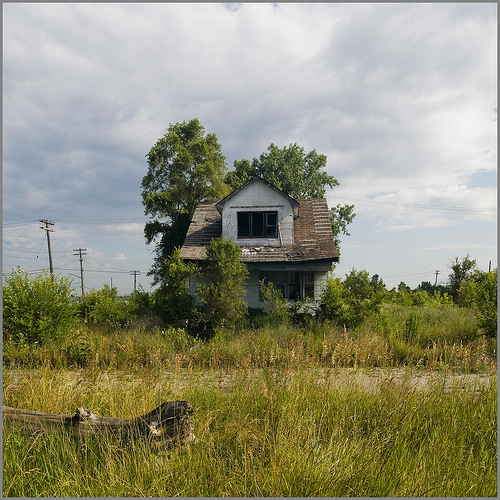
From the "Feral Houses" series
Last week, Flavorpill's Flavorwire newsletter introduced me to James Griffioen's photography. "Feral Houses," the series featured by Flavorpill, focuses on abandoned houses in Detroit, Michigan. Griffioen writes,
"For a few beautiful months every summer, some of the tens of thousands of abandoned houses become feral in every sense: they disappear behind ivy or the untended shrubs and trees planted generations ago to decorate their yards. As the city of Detroit disappears, nature is flourishing."Considered as a whole, the "Feral Houses" series is a record of our complicated relationship with the land upon which we live and depend, as well as of our ailing community roots.
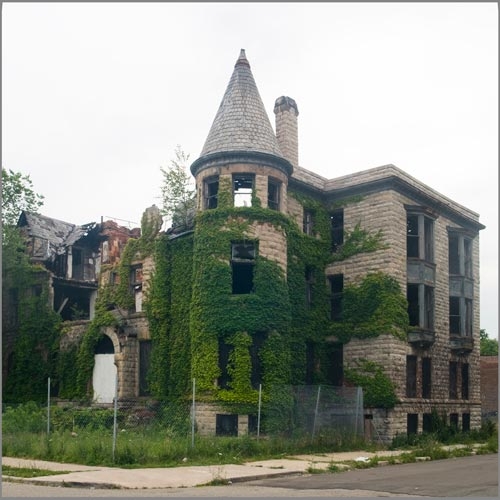
From the "Feral Houses" series
Detroit's Rust Belt era history is generally bleak. Today, much of the city is classified as a food desert. Sitting down for a hearty meal with friends and family this Thanksgiving evening, I recalled Rebecca Solnit's inspiring Harper's Magazine article, "Detroit Arcadia" (July 2007). Solnit writes,
"Detroit is a cautionary tale about one-industry towns: it shrank the way the old boomtowns of the gold and silver rushes did, as though it had been mining automobiles and the veins ran dry, but most of those mining towns were meant to be ephemeral. People thought Detroit would go on forever. [...] I took many pictures on my visits to Detroit, but back home they just looked like snapshots of abandoned Nebraska farmhouses or small towns farther west on the Great Plains. Sometimes a burned-out house would stand next to a carefully tended twin, a monument to random fate; sometimes the rectilinear nature of city planning was barely perceptible, just the slightest traces of a grid fading into grassy fields accented with the occasional fire hydrant. One day after a brief thunderstorm, when the rain had cleared away and chunky white clouds dotted the sky, I wandered into a neighborhood, or rather a former neighborhood, of at least a dozen square blocks where trees of heaven waved their branches in the balmy air. Approximately one tattered charred house still stood per block. I could hear the buzzing of crickets or cicadas, and I felt as if I had traveled a thousand years into the future."Yet the central focus of Solnit's essay are the heroic, local reclamations of Detroit's abandoned lots for community gardens or small-scale farming enterprises.
"I also saw the lush three-acre Earth Works Garden, launched by Capuchin monks in 1999 and now growing organic produce for a local soup kitchen. I saw a 4-H garden in a fairly ravaged east-side neighborhood, and amid the utter abandonment of the west side, I saw the handsome tiled buildings of the Catherine Ferguson Academy for Young Women, a school for teenage mothers that opens on to a working farm, complete with apple orchard, horses, ducks, long rows of cauliflower and broccoli, and a red barn the girls built themselves. I met Ashley Atkinson, the young project manager for The Greening of Detroit, and heard about the hundred community gardens they support, and the thousands more food gardens that are not part of any network. The food they produce, Atkinson told me, provides food security for many Detroiters. 'Urban farming, dollar for dollar, is the most effective change agent you can ever have in a community,' she said. Everywhere I went, I saw the rich soil of Detroit and the hard work of the gardeners bringing forth an abundant harvest any organic farmer would envy."Similar projects are gaining momentum in American cities that aren't suffering as acutely as Detroit. Community garden and farmer's market movements are thriving in many urban centers, and urbanite hunters are no longer unheard of. Last week, the New York Times reported on the growing number of locavores taking up hunting, but, unlike Charlottesville, Virginia's "Deer Hunting for Locavores" class and San Francisco's Bull Moose Hunting Society, ventures made possible by relative privilege and foresight, Detroit's repurposing and enterprise is born of pressing need.
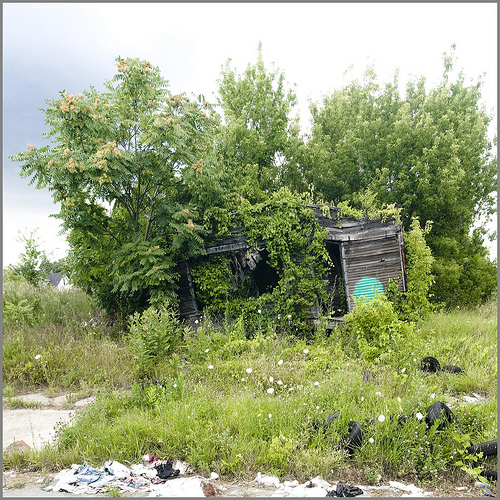
From the "Feral Houses" series
Contemplating Griffioen's handsome photographs, it's impossible not to think of Detroit's economic and health struggles. Still, his subjects, the "feral houses" themselves, don't strike this Eastern Shore boy as that unusual. All regions marked by poverty offer up monuments to the ceaseless action of Nature and time. Recent studies show that Accomack, the Virginia county that I was raised in and that my parents call home, is "the fattest" county in the state. It is also one of the poorest. Abandoned houses and overgrown automobiles figure as prominently in my mental portrait of the Shore as do salt marshes and the rich smell of freshly turned earth.
Unlike the citizens of Detroit's urban environment, Eastern Shore folks are not strangers to hunting, fishing, or farming. One might therefore assume that food desertification and obesity are unlikely. Unfortunately, access to fresh, healthy foods doesn't mean that locals won't instead opt for fast food! Furthermore, community ties might be even weaker on the Shore than they are in Detroit, eroded in part by an epidemic reliance on the automobile and big-box stores.
What does the future portend for Detroit and Virginia's Eastern Shore? Taking the long view, I'm optimistic. A decade hence, Detroit might well provide a more sustainable model for beleaguered urban communities. The Eastern Shore, however, is a different type of community, and one still on the decline; recovery will come more slowly.
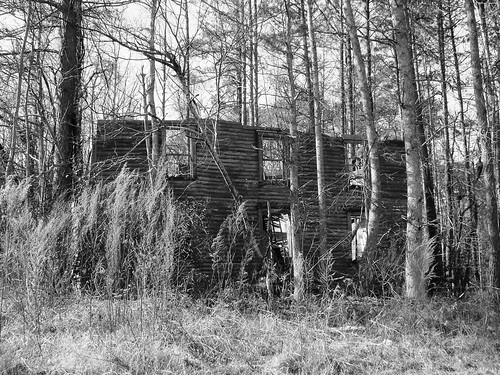
House on White's Neck Road; Parksley, Virginia
Like Griffioen's pictures, Don Amadeo's photographs of the Eastern Shore remind us of the slow creep of geologic time, the long long view. Human communities may rise and fall and rise again, but all eventually succumb. So, too, with species. There is an ambivalent beauty in overgrown ruins; they celebrate the wonder of life's eternal striving even as they proclaim mortality.
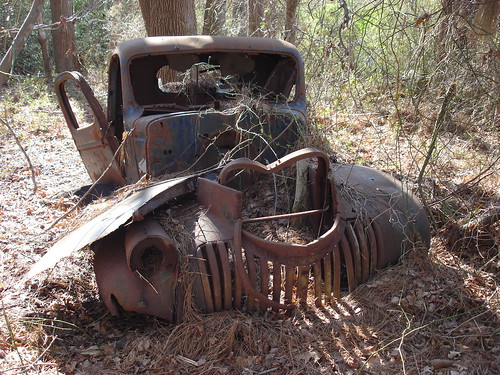
Ole Rusty; Parksley, Virginia
Photo credit: "Feral Houses" photographs, courtesy James Griffioen; ShoreRebel photographs, courtesy Don Amadeo

8 comments:
I've followed James Griffioen's blog for a couple years -- http://www.sweet-juniper.com/ In it, he blends tales of being a stay-at-home-dad with essays and photos about their chosen city. Check out the "Detroit" and "abandoned places" tag threads.
Lisa:
Thank you for letting me know about Griffioen's blog. I will definitely check it out.
I hope that you're thriving in Boston as winter begins to lay down its hand.
I love this post. In total, very well written, very well said.
Two things occurred to me while reading. Nothing of deep importance, and maybe tangential to your piece. But I'll note them anyway.
First, I've got to wonder what kind of toxins all those urban gardens are picking up. Studies have shown that plants growing a short distance away from arsenic-treated lumber have high levels of the poison, and who knows what's been dumped in the ground around Detroit? A town in my county here has gutters that run fluorescent orange when it rains due to contamination from a Ford paint plant.
Second, you use the term "food desert", which I guess is okay, but then you suggest that food desertification is connected to obesity. I know you can't research everything yourself and you have your own interests to keep up with. But obesity is one of my pet areas of study -- being obese myself -- and I can tell you that the connection many people make between obesity and fast food is a flip one. It looks good on paper, but then so does flat Earth, and the sun going around it. Obesity researchers honestly don't know why so many Americans are obese. There is a correlation between obesity and economic status, and there's some correlation between economic status and food quality, but in fact the correlations aren't that strong and the causes of either are obscure. Fact is, plenty of skinny people eat a lot of fast food, and plenty of obese people eat vegetables.
If you can slip it into your reading list, and you're interested, I recommend
Rethinking Thin by Gina Kolata. It sums up the last hundred years or so of obesity research. Short summary: It's much more complicated than most people think.
Just my pet project, educating people about obesity.
Here, two examples from western New Jersey of feral cars and advertising.
Chris:
Thanks for the thoughtful comment.
Your concern about toxins present in the vegetables grown in urban community gardens is an important one. Unfortunately, many of the toxins present in urban soils are also present in urban air and water. They're therefore affecting local populations regardless of whether or not they eat locally grown food. Moreover, the chemicals used by industrial agriculture and pharmaceutical companies are, in many cases, no less capable of fundamentally altering our corporeal chemistry.
Testing in the United States is revealing alarming concentrations of various "poisons" in urine from rural, suburban, and urban populations alike (as well as in mammals, fish, and other non-human animals). The particular poisons detected differ, of course, but the salient point is that we're gambling with our health and the health of future generations. That being the case, I'd rather risk poisoning from a more ethical diet than from the grossly immoral and unethical industrial model.
Having said all that, I do think that testing should be done. Perhaps it is already being investigated? The truth is, I really don't know what toxins are present in urban garden vegetables. I should dig a bit (bad pun intended)!
Also, thanks for your thoughts on obesity. In fact, I didn't intend to connect the food desert phenomenon with obesity, though I did imply a connection between an over-reliance on fast food and additional girth. I appreciate that the correlation is not so clear as I suggested.
Dr. Jeffrey Friedman, head investigator at one of the labs here at Rockefeller University, studies obesity and genetics. He collaborates with our lab, and his research makes it abundantly clear that inheritance is the most important factor in obesity. They've even dubbed a gene "the obesity gene," as you probably know.
Finally, your pictures of the "reclaimed" truck are great. I love looking at pictures like that. Thanks for sending them.
I've heard vague and distant rumblings about an obesity gene but not much more. I'm looking into it now, thanks. I'm pretty sure I have two or three obesity genes judging by my increasing pants size.
I looked at Dr. Greengrass' page there. Wow. I now feel like a dope. Me put paint on wood, me no understand, uh, cyclic AMP-regulated phosphoprotein.
Chris:
I'm in the same boat as you...and I help edit the scientific grants!
A decade hence the Eastern Shore may be under water. This week I visited my grandmother's cottage (shack) near Tilghman Island, MD. We couldn't pull into the driveway (portion of the yard designated for parking) for fear that the Prius would sink. Our car has gotten stuck on every visit in the past 5 years or so. Yet when I lived there in the summer of '95, my gigantic diesel beast of a car never once got stuck. I'm starting to think we should put the house up on pilings.
AndisCandis:
At the very least, the shoreline of the Eastern Shore will be redrawn by the ocean and the bay.
Have you seen the sea level rise predictions for the region? The western shore of the Chesapeake is more adversely affected, but the peninsula is not spared, by any means! Fortunately, the barrier islands on the Atlantic side will help mitigate storm surge effects.
Unfortunately, many people continue to dismiss global warming and the pertinent environmental symptoms. Perhaps the percentage of those in denial is even higher on the Shore? It certainly wouldn't surprise me!
Post a Comment